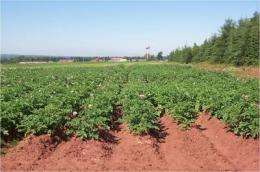It's elemental: Potato after-cooking darkening may be affected by nutrients

Irish potato, one of the world's major food crops, is increasingly grown and processed for use in various products; consider the popularity of consumer favorites like French fries and potato chips. In the closely scrutinized food production industry, products are accepted or rejected on the basis of color and appearance, among other attributes. Quality defects such as after-cooking darkening, or ACD -- a change in potato's normal flesh color to gray, blue, purple, or black -- can affect the marketability of potatoes for both processing and fresh markets. With the current expansion of the potato-processing industry around the world comes a renewed interest in finding innovative methods to prevent ACD.
After-cooking darkening occurs when potatoes are exposed to air after cooking, including boiling, baking, frying, or dehydration. ACD has been reported from every potato-growing area in the world and is one of the most widespread, undesirable traits for potatoes and other tubers, even though it does not affect the flavor or nutritional value of the crops. ACD is most common in boiled or steamed potatoes, but is also problematic in processed products such as oil-blanched French fries, dehydrated potatoes, canned potatoes, prepeeled potatoes, and reconstituted dehydrated potatoes.
Researchers at Nova Scotia Agricultural College hypothesized that the concentration and distribution of elements in potato tubers could be used to predict after-cooking darkening. The objective of the study, published in a recent issue of HortScience, was to identify the elements (plant nutrients) whose content may relate to the severity of potato ACD. The researchers grew two common potato cultivars ('Shepody' and 'Russet Burbank') in three Eastern Canadian provinces for two seasons using various fertilization regimes. Fourteen elements were studied: phosphorus, calcium, magnesium, potassium, sulfur, iron, copper, sodium, zinc, boron, manganese, aluminum, silicon, and chlorine.
The "After Cooking Darkening" readings were found to be affected by fertilizer and a "cultivar-segment interaction". ACD readings were higher in tubers from fertilized plots compared with tubers from nonfertilized plots. The distribution of ACD was found to be similar in both cultivars studied, with the stem end being the darkest, the center segment being the lightest, and the flesh darkening again slightly toward the bud end. The elements most strongly correlated with ACD severity were phosphorus, calcium, copper, and magnesium. According to the researchers, the study provides a useful method to predict the severity of ACD, which could assist the potato processing industry in predicting the occurrence of ACD and in developing agronomic treatments to minimize it.
"This study demonstrated how information from element distribution can be used in predicting the occurrence of a tuber quality trait, specifically ACD", commented Dr. Gefu Wang-Pruski, corresponding author of the study.
The authors note that additional experiments to determine how tuber element content affects the change in ACD severity over time may make it possible to predict the severity of ACD in tubers in late stages of storage by determining the element concentrations and their spatial distribution of the same lot of tubers at harvest.
More information: The complete study and abstract are available on the ASHS HortScience electronic journal web site: hortsci.ashspublications.org/c … t/abstract/44/7/1866
Provided by American Society for Horticultural Science


















